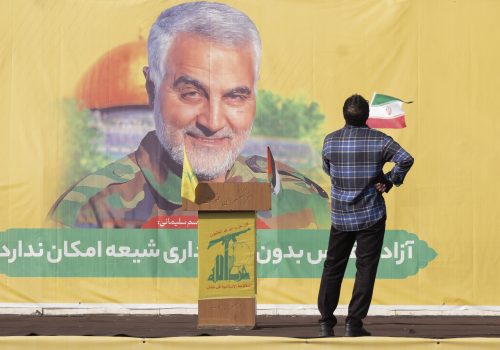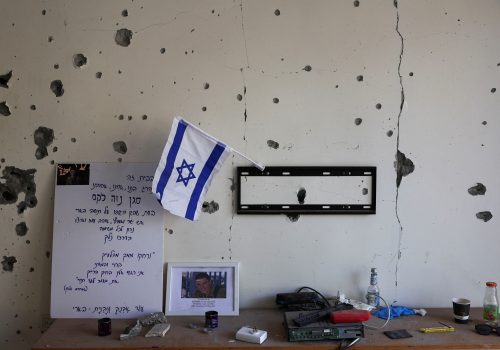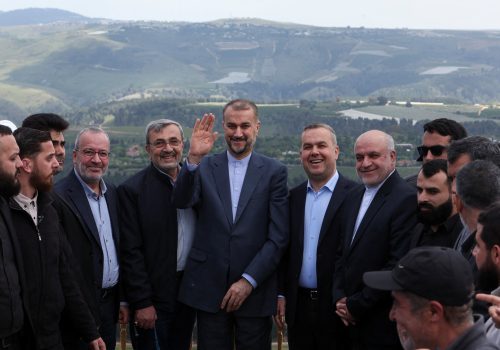‘Unification of the arenas’ might turn from an opportunity for Iran into a threat
In the five months since the outbreak of the war in Gaza, it has become clear that Iran is growing increasingly concerned with the possibility of further regional escalation. This escalation could potentially draw Iran into an unwanted confrontation, not only with Israel but also with the United States. The war has provided Tehran with its first opportunity to implement the concept of “unification of the arenas,” aimed at enhancing the balance of deterrence against Israel. This strategy involves increasing coordination and cooperation among the elements of the Resistance Axis. The integration of Hezbollah from Lebanon, the Iraqi Shia militias, and the Houthis in Yemen into the campaign against Israel and the United States has demonstrated the pro-Iranian axis’s ability to act with strategic synchronization.
In recent years, the Palestinian arena has been emphasized even more strongly as a central struggle of the pro-Iranian axis in the framework of this concept. In Iran’s view, the normalization process between Israel and the Arab countries created an opportunity for increased coordination between the terrorist organizations Hamas and Palestinian Islamic Jihad (PIJ) and the other elements in the axis around the struggle against Israel as their common enemy. As part of realizing this strategy, Tehran decided to establish a joint operations room, which will be responsible for the coordination and overall military, logistical, and intelligence planning among the network of partners and proxies Iran established in the region. However, the activation of the network at Iran’s initiative and at a time convenient for the Islamic Republic was intended, first and foremost, to serve Iranian interests—primarily, to deter Israel from attacking Iran’s nuclear targets or its main ally, Hezbollah.
The initiation of the October 7, 2023 attacks by Hamas, which triggered a region-wide war, surprised Iran, especially the timing of the attacks. This presented Tehran with an increasingly difficult dilemma: how to preserve the cohesion of the pro-Iranian axis without being drawn into a direct military conflict with Israel and the United States. It is no surprise that Supreme Leader Ayatollah Ali Khamenei expressed dissatisfaction with the timing of the attacks. According to a Reuters report, Khamenei told Hamas leader Ismail Haniyeh during their November 2023 meeting that Iran would not directly intervene in the war because it was caught off guard by October 7. He also urged to silence the voices within Hamas that publicly called for Iran and Hezbollah to join the campaign against Israel in full force.
A prominent manifestation of Iran’s growing fear of being dragged into a direct military conflict can be observed in the events that followed the drone attack carried out by the Iraqi Shia militias on the US logistics support base in northeastern Jordan on January 28. A few hours after the attack, which resulted in the deaths of three US soldiers, Esmail Qaani, the commander of the Islamic Revolutionary Guard Corps (IRGC) Quds Force, arrived in Baghdad and instructed the leaders of the Iraqi militias to cease their attacks against US forces in Syria and Iraq. According to one report, Qaani emphasized that the militias must maintain a low profile to prevent US retaliatory strikes, including against Iran. He stated that the militias had crossed a red line and that Iran could not afford military actions that might provoke the United States or Israel into starting a war. Indeed, shortly after he arrived in Baghdad, the secretary general of the Iraqi Hezbollah Brigades militia announced the suspension of military activities against US forces in the region.
SIGN UP FOR THE THIS WEEK IN THE MIDEAST NEWSLETTER
Qaani’s success in de-escalating tensions in the Iraqi arena may strengthen the assessment that Iran retains the ability to significantly influence its partners and proxies throughout the Middle East. However, Tehran’s ability to ensure complete control over the elements of the Resistance Axis should not be overestimated. The axis does not function as a hierarchy with direct Iranian command and control, but as a loose network of interconnected components driven by common interests and a shared ideological vision. Furthermore, in recent years—mainly since the assassination of IRGC Quds Force Commander Qasem Soleimani in 2020—Iran has managed its proxies in a more decentralized way than before. While it continues to have substantial influence within the network, it does not necessarily enjoy complete control over each component. The transformation of the axis into a decentralized network has provided Iran with greater flexibility, the ability to deny involvement, and the option to distance itself from provocative actions by its partners. However, it also carries risks because the weakening of Iranian control could lead to uncoordinated actions by its partners that endanger Iranian interests.
In this context, it is possible to understand the Reuters report on March 15, which suggests that Iran and Hezbollah are well aware of the risks associated with an Israeli attack on Hezbollah, including the potential escalation to attacks on Iranian nuclear facilities. According to the report, during a meeting in Tehran in February—attended by the commander of the IRGC, the commander of the IRGC Quds Force, and representatives from the Resistance Axis in Syria, Lebanon, Yemen, and Iraq—all participants agreed that Israel aims to widen the conflict and that efforts should be made to avoid falling into this trap. This is because such escalation could lead to the presence of additional US soldiers in the region. A few days later, Hezbollah Secretary General Hassan Nasrallah conveyed to the commander of the Quds Force that, in the event of a war with Israel, Hezbollah would take on the fight itself because it has no interest in Iran being dragged into a conflict with Israel or the United States.
In conclusion, Iran developed the “unification of the arenas” strategy to deter Israel from initiating a war against it or Hezbollah. However, Hamas’s decision to start a war at a time not determined by Iran created a situation of escalating risks. The unification strategy, which was designed to provide deterrence against Israel, could potentially drag Iran into an unwanted military conflict. As time passes, it becomes evident that Iran fears the possibility of an all-out war between Israel and Hezbollah, and perhaps even Israel taking advantage of the opportunity to attack Iran’s nuclear facilities. According to a New York Times report, Khamenei even instructed his army commanders to adopt a policy of “strategic patience” and to avoid any actions that could lead to a significant escalation, thus avoiding direct military confrontation with Israel or the United States. The day after the war, the Islamic Republic will also be required to reassess its security strategies and examine whether their benefits still outweigh the risks involved.
Dr. Raz Zimmt is a senior researcher at the Institute for National Security Studies and the Alliance Center for Iranian Studies at Tel Aviv University. He is also a veteran Iran watcher in the Israeli Defense Forces. Follow him on X: @RZimmt.
Further reading
Wed, Nov 8, 2023
The Gaza war raises questions about the future of Iran’s Resistance Axis
IranSource By
The Gaza war presents the first significant test of the level of cooperation present among the elements of the Iran-led Resistance Axis.
Thu, Dec 7, 2023
Does the Resistance Axis believe its propaganda about Israel? The October 7 attack seems to suggest so.
IranSource By
For the Resistance Axis, portraying Israel as a temporary entity that will inevitably melt away has an obvious utility, and is one that furthers the goal of destroying the Jewish state.
Thu, Jul 6, 2023
Hezbollah and Iran have opened a fourth battlefront: Inside Israel
IranSource By David Daoud
Critical as recent developments may prove, they obscure a more dangerous Hezbollah initiative to establish a proxy foothold inside Israel.
Image: Portraits of the Islamic Revolutionary Guard Corps' (IRGC) Quds Force, Major General Qasem Soleimani, the flag of Lebanon's Hezbollah, and Iranian flags are being displayed at a war toys and religious accessory shopping mall in downtown Tehran, Iran, on the anniversary of the killing of Qassem Soleimani at Baghdad Airport by the United States, on December 30, 2023. (Photo by Morteza Nikoubazl/NurPhoto)


